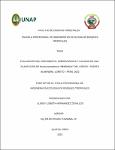Evaluación del crecimiento, sobrevivencia y calidad de una plantación de Hevea brasiliensis “shiringa” del CIEFOR – Puerto Almendra, Loreto – Perú. 2022
Abstract
The study was carried out in Forest Plot No. 31 of 1 hectare in CIEFOR - Puerto Almendra, 102 Hevea brasiliensis plants were evaluated. The objective of the study was to determine the increase in diameter and height, the survival, mortality and quality of the plants. The plantation presented an average increase in diameter of 3.17 mm and an average increase in height of 20.51 cm. The research hypothesis is rejected, indicating that the growth in diameter and height of the plants do not present statistical difference. There was a mortality of 49% (98 dead plants) and 51% survival (102 live plants). The highest number of seedlings is presented by the Regular quality with 79 seedlings that represents 77.5% of the total number of living plants, followed by the Good quality with 20 living individuals that represent 20.0% and, finally, the least number of individuals. They were observed in the Good quality with 3 seedlings that represented 2.9% of the total. At the general experimental level, a quality coefficient that varies from bad to regular was recorded. It is necessary to continue with the evaluations in plot No. 31 of Hevea basiliensis in CIEFOR - Puerto Almendra. El estudio se realizó en la Parcela Forestal No. 31 de 1 hectárea en el CIEFOR - Puerto Almendra, se evaluaron 102 plantas de Hevea brasiliensis. El objetivo del estudio fue determinar el incremento en diámetro y altura, la sobrevivencia, mortalidad y calidad de las plantas. La plantación presentó un incremento promedio en diámetro de 3,17 mm y un incremento promedio en altura de 20,51 cm. Se rechaza la hipótesis de investigación, indicando que el crecimiento en diámetro y altura de las plantas no presentan diferencia estadística. Se tuvo una mortalidad de 49% (98 plantas muertas) y un 51% sobrevivencia (102 plantas vivas). El mayor número de plántulas lo presenta la calidad Regular con 79 plántulas que representa el 77,5% del total de plantas vivas, seguido por la calidad Bueno con 20 individuos vivos que representan el 20,0% y, finalmente la menor cantidad de individuos se observaron en la calidad Bueno con 3 plántulas que representó el 2,9% del total. A nivel experimental general, se registró un coeificiente de calidad que varía de malo a regular. Es necesario continuar con las evluaciones en la parcela N°31 de Hevea basiliensis en el CIEFOR - Puerto Almendra.
Collections
- Tesis [526]


